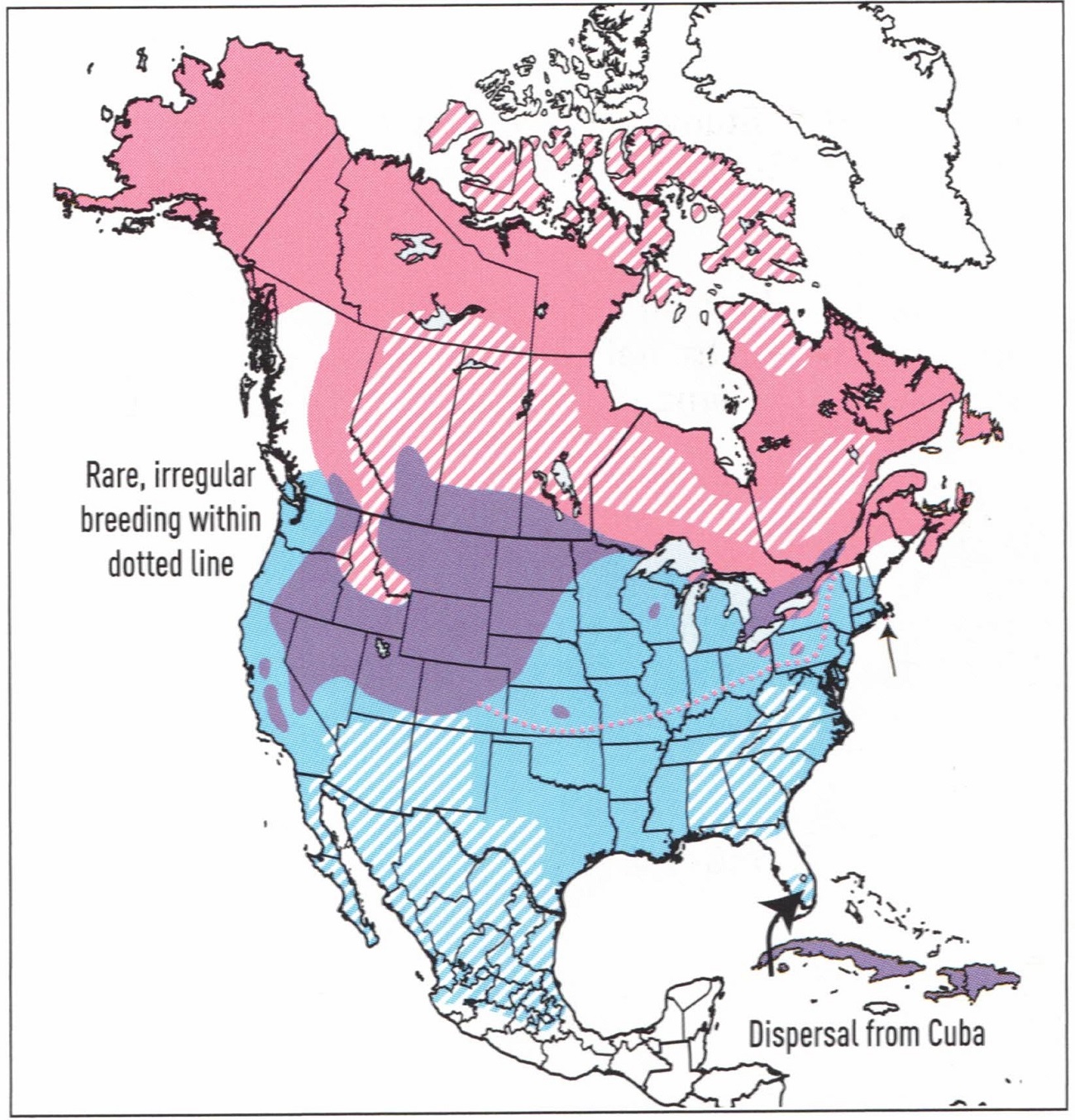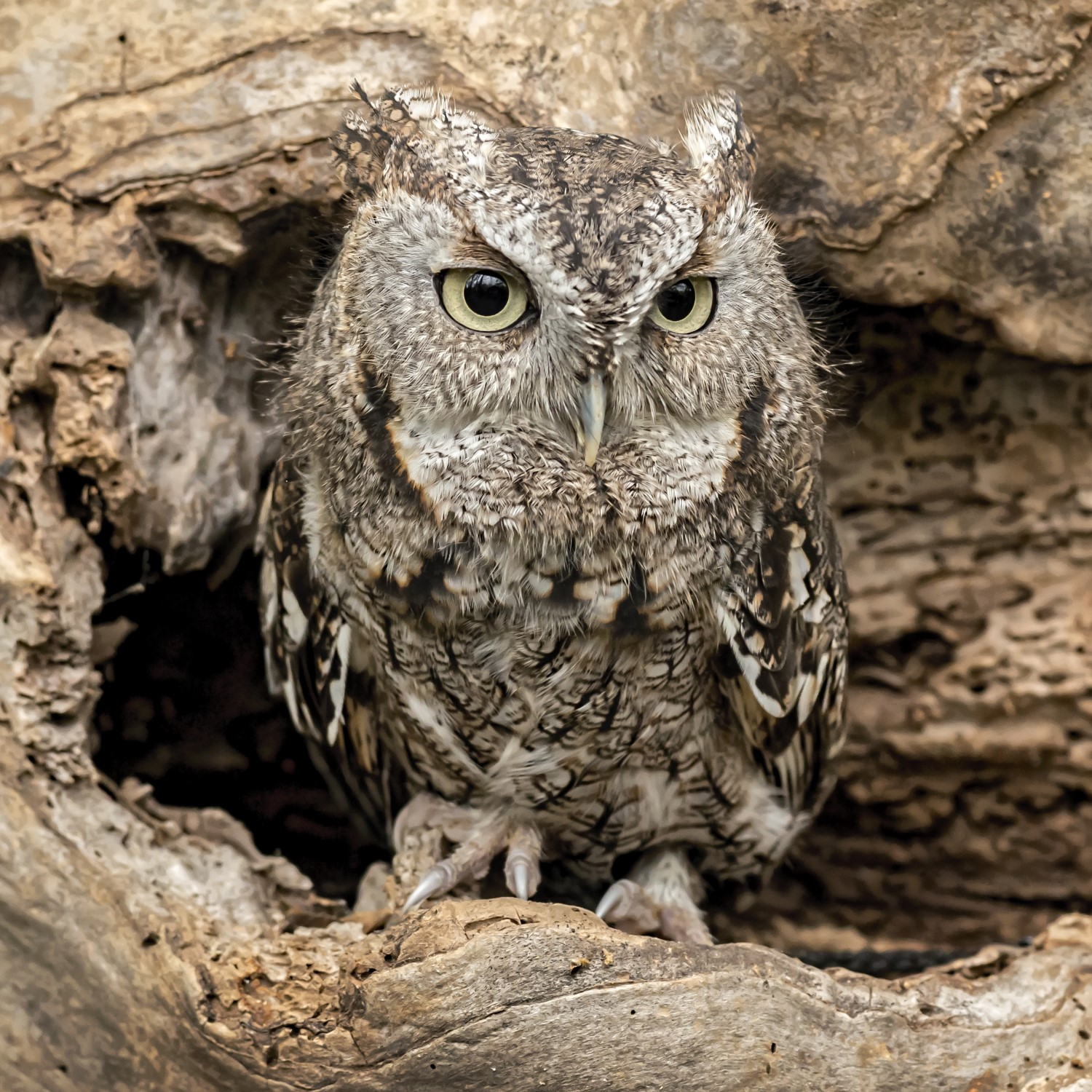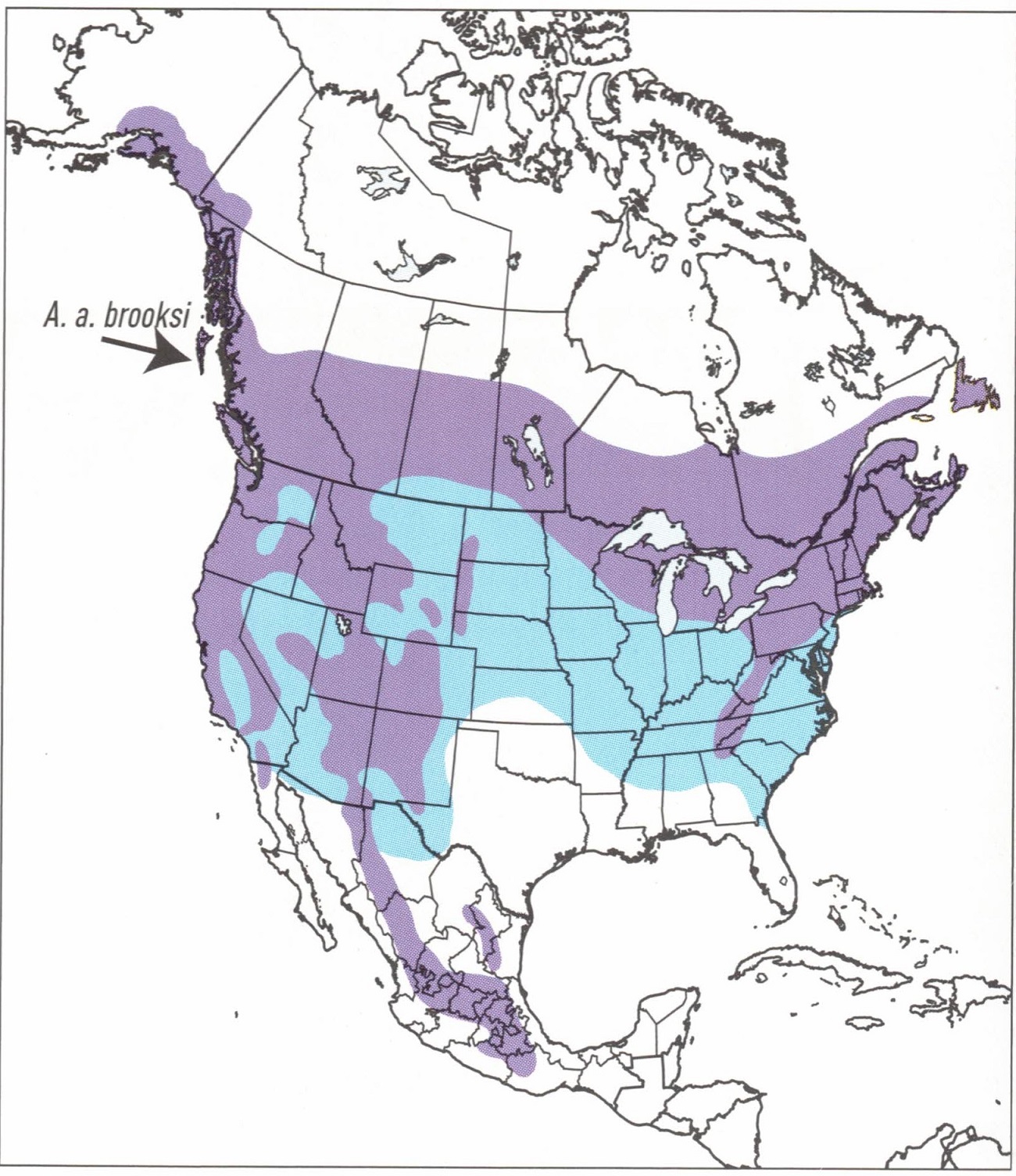Nothing is more exciting than spotting an owl in your backyard if you live in New Jersey. These magnificent birds of prey are a beautiful sight to behold. If you’re an avid birdwatcher, you’re probably eager to identify which types of owls are visiting your property.
There are 8 owl species found in New Jersey, including the Long-Eared Owl, Short-Eared Owl, Barred Owl, Barn Owl, Eastern Screech-Owl, Snowy Owl, Northern Saw-Whet Owl, and Great Horned Owl. While several of these owl species have their preferred mating and migratory ranges, it’s possible to spot a vagrant or irrupting owl in areas outside their known territories. If you see an owl in New Jersey that is not on this list, consider yourself lucky!

The legend below can be used to help you determine where each of the 8 owls of New Jersey lives during different parts of the year.

The 8 Species of Owls in New Jersey

Long-Eared Owl
Asio otus
Order: Strigiformes
Family: Strigidae
Size: 14-16 in. (35-40 cm)
Overview
At 15 inches in length and with an impressive wingspan of 39 inches, the long-eared owl has been known to steal nests away from jays and crows to raise their own young. This somewhat elusive owl can be tough to find, preferring to seek shelter in dense woodlands. And, unfortunately, its population has declined 91% since 1970. Unlike most owls, long-eared owls are not very territorial and prefer to rely on their camouflage to hide from potential predators. When confronted, most long-eared owls simply fly away. Because these birds can be skittish, they can be tough for birdwatchers to track down. But if you are lucky enough to spot a long-eared owl, keep your eyes peeled for more — long-eared owls roost in groups of 6 to 50.
How to Identify
At first glance, the long-eared owl greatly resembles the great horned owl. But a closer inspection reveals that long-eared owls possess a distinctive V-shaped feather pattern on their faces. The tufts of feathers that make up their face disks surround bright orange eyes, giving them a surprised expression. The second set of feather tufts sitting on top of their heads gives them their iconic long-eared appearance These are lanky birds that have tan faces with variegated plumage in shades of brown, tan, gray, and white.
Long-Eared Owl Range & Migration Map
Long-eared owls live year-round in Wyoming, Nevada, Colorado, Arizona, New York, Michigan, and Wisconsin. During the breeding season, these birds venture farther north to Montana, North Dakota, and Minnesota. These birds can be spotted in all but the southernmost portion of Florida, Alabama, Mississippi, Louisiana, and Texas. Long-eared owls prefer to live in open spaces that have dense clusters of scattered trees, providing them with a safe place to seek shelter as they hunt for small mammals.


Short-eared Owl
Asio flammeus
Order: Strigiformes
Family: Strigidae
Size: 14.5-15 in. (37-38 cm)
Overview
A classic birdwatcher favorite, short-eared owls hunt during the daytime and can be found throughout the United States. These owls are some of the few that prefer to build their own nests. Females construct their bowl-shaped nests in the ground, lining them with feathers, grasses, and other soft materials before laying clutches of 4 to 7 eggs. Short-eared owls have very distinctive flight patterns, with irregular wingbeats similar to that of bats or moths. These birds are typically 17 inches in length and have wingspans of up to 43 inches. They use their powerful wings to stay upright as they swoop feet-first to capture their prey, which consists of small mammals, rodents, reptiles, and amphibians. Short-eared owls sometimes dine on songbirds and will tear the wings off before swallowing them whole.
How to Identify
The ear tufts of the short-eared owl are situated towards the center of their heads, and they’re so short that sometimes they may not be visible at all. Short-eared owls have tawny plumage on their backs and wings with tan bellies that are interspersed with vertical dark brown streaks. Tailfeathers are barred. These owls have small, round faces with pale tan to creamy white facial disks accented by black-brimmed yellow eyes. Short-eared owls use sharp “waowk-waowk-waowk” calls to communicate and “eeee-yerp” cries during the mating season.
Short-eared Owl Range & Migration Map
Excellent long-distance fliers, short-eared owls have been reported landing on watercraft hundreds of miles from shore. These birds will fly over the ocean and land to reach their breeding grounds in northern Canada. You can find short-eared owls living year-round in the north and northwest portions of the United States. But, because they travel regularly, you can spot stragglers in nearly every state in the nation. These birds prefer to dwell in open areas, including grasslands, marshes, and farmland.


Barred Owl
Strix varia
Order: Strigiformes
Family: Strigidae
Size: 19-22 in. (48.25-56 cm)
Overview
Masters of camouflage, barred owls can be tough to spot. Fortunately, their loud hooting calls “Who cooks for you? Who cooks for you all?” are easy to hear. Barred owls prefer to dwell in forests where they can track down rabbits, squirrels, and even raccoons. These owls saw a serious population boom in the 20th century, expanding their range to include forestland in the western states. Barred owls tend to stay close to home throughout their lives, often only traveling around a 6-mile radius. Like barn owls, barred owls are monogamous and do most of their hunting at night.
How to Identify
With their deep brown eyes and gentle round faces, barred owls look exactly as you would expect owls to look. These birds are covered in red-brown feathers with white horizontal stripes or bars. Barred owls are most commonly spotted on the edges of forests at dusk, where they can easily locate their prey.
Barred Owl Range & Migration Map
Once relegated to southeastern Canada and New England, the barred owl expanded westward. These owls can now be found in parts of Minnesota, Nebraska, Kansas, and Oklahoma. Barred owls have become quite adaptable, and can be spotted in urban areas as well as rural regions. These birds are extremely territorial, with mated pairs getting into hooting matches with outsiders in order to defend their homes.


Barn Owl
Tyto alba
Order: Strigiformes
Family: Tytonidae
Size: 12.5-16 in. (32-40 cm)
Overview
Easily recognized by their pale heart-shaped faces, barn owls are some of the most widespread owls in the world. These owls thrive in deserts and grasslands, but can even be found in polar regions. Barn owls are especially common on farms, where they like to hunt for field mice among the crops in the morning and evening, and where they can take shelter in barns during the daytime. With their serrated wings, these fearsome predators fly noiselessly as they go in for the kill. Barn owls are monogamous, mating for life. They do not build nests but prefer to lay their eggs in the hollows of trees. The amount of food these birds receive has a direct impact on how many eggs they lay — the more voles, rats, and shrews they consume, the more owlets in their brood.
How to Identify
Barn owls are quite lanky compared to other owls. They have large hazel to brown eyes set in concave, heart-shaped faces that are surrounded by a delicate outline of pale brown feathers. Barn owls are milk white in color with tan and rust brown feathers on their backs and wings. These owls do not hoot but instead prefer to communicate via screeches.
Barn Owl Range & Migration Map
You can find the barn owl in all but the uppermost region of the U.S. Even though these birds are common throughout the nation, their population is dwindling somewhat due to habitation loss. Barn owls reside year-round as far south as Texas and Arizona, as far east as Pennsylvania, and all across the Pacific Northwest.


Eastern Screech-Owl
Megascops asio
Order: Strigiformes
Family: Strigidae
Size: 6-10 in. (16-25 cm)
Overview
Featuring 5 subspecies, eastern screech-owls are small birds maxing out at just under 10-inches in length. These owls are monogamous and less skittish than other owls, frequently living in nesting boxes and even using birdbaths to wash up. Eastern screech-owls are typically easy to spot because they prey on songbirds during the daytime. This little raptor’s size proves deceptive. These are highly territorial birds, even from a young age. Young eastern screech-owls will fight amongst themselves for food, and may even kill the smallest and weakest of their siblings — an act known as siblicide that is common in birds of prey.
How to Identify
Eastern screech-owls are short, stocky birds with small heads and square tails. These owls occur in gray morphs and red (or rufous) morphs, with some owls exhibiting brown plumage. The color of each eastern screech-owl depends on the type of forest it resides in, as its coloring helps to camouflage it from potential predators. These are very vocal owls that use trilling calls to attract mates and communicate with their families. Their distinctive whinny-like screeches are hard to miss!
Eastern Screech-Owl Range & Migration Map
Eastern screech-owls prefer to live in forests but are often happy to live in urban areas, too. You can find the eastern screech-owl from Vermont to Montana, in a broad range sweeping all the way down to Texas and back across the states to Florida. These birds can be found in wooded, rural, and suburban settings.


Snowy Owl
Bubo scandiacus
Order: Strigiformes
Family: Strigidae
Size: 20.5-27.9 in. (52-71 cm)
Overview
Snowy owls are the heaviest owls, with adults averaging between 3 and 5 pounds. Their dense plumage makes them weightier, but it also allows them to withstand the cold temperatures of the Arctic tundra. These are powerful birds at roughly 28 inches long with a wingspan of 57 inches. They’re aggressive, too, using their sharp talons and strong feet to defend their territories from predators and competitors. These owls hunt almost exclusively during the daytime and can eat more than 1,600 lemmings in a year. Their voracious appetites can have a devastating impact on their food supply, but these skilled fliers are willing and able to fly south in search of prey. Snowy owl populations have declined 64% since 1970 due to illegal hunting and vehicle collisions, as well as climate change.
How to Identify
Juveniles of the species have brown and black markings over a base of white plumage. As these birds age, they lose most of their markings. At maturity, males will be almost pure white, with females retaining some of their patternings. These owls have hoarse voices and use a variety of calls, the most frequent of which is a rhythmic “krooh-krooh-krooh-krooh”.
Snowy Owl Range & Migration Map
Snowy owls don’t live in the United States all year long, however, they do winter in the northern states. You can see snowy owls from Washington all the way across to Maine. In years when their preferred prey was especially limited, snowy owls were sighted as far south as Florida, so it’s possible to spot one of these beauties no matter where you are in the U.S.


Northern Saw-whet Owl
Aegolius acadicus
Order: Strigiformes
Family: Strigidae
Size: 8-8.5 in. (20.3-21.5 cm)
Overview
These owls are short and compact. At just 8 inches in length and with a wingspan of 22 inches, northern saw-whet owls are among the smallest owls in the United States. Northern saw-whet owls like to prey on deer mice, using their sharp beaks to tear their prey into smaller pieces, breaking up a single mouse into several meals. Because these owls are nocturnal, and because they’re so small, they can be difficult to track. But their sharp cries make it easier to locate them in their forest homes. Northern saw-whet owls are mostly solitary creatures, only socializing with their mates. Females have been known to have two mates, leaving the first to raise a brood with the second. These owls have porphyrin pigments in their feathers, and when illuminated with a UV light, the ventral side of the wings shows a neon pink color. This helps researchers determine an owl’s age.
How to Identify
Named because its call sounds like a saw being sharpened on a whetstone, saw-whet owls have small heads and cat-like faces with relatively large yellow eyes. With rust-colored backs, breasts, and wings, northern saw-whet owls have spotted heads and distinctive Y-shaped markings on their faces. These owls use a variety of vocalizations to communicate. They’re most easily identified by their shrill “too-too-too” calls, which they use to attract mates. The cries of northern saw-whet owls are so loud that they can be heard nearly 1,000 feet away.
Northern Saw-whet Owl Range & Migration Map
One of the most common owls in the U.S., the northern saw-whet prefers to dwell in mountain forests. They can be found year-round in California, New Mexico, Utah, and Colorado, and in the northeastern states, Minnesota, Wisconsin, Michigan, New York, and all the way through to Maine. These owls can be seen in other territories, too, during non-breeding times. It’s not unheard of to see northern saw-whet owls throughout the midwest, including Kansas, Missouri, and Illinois.


Great Horned Owl
Bubo virginianus
Order: Strigiformes
Family: Strigidae
Size: 18-26 in. (46-63 cm)
Overview
Far from meek, Great Horned owls have been known to hunt other birds of prey, including ospreys, peregrines, and even other owls. With their strong talons, these birds can exert 28-pounds of force allowing them to tackle larger prey. Great orned owls are a major threat to other birds, especially jays and crows. In fact, if you ever hear a large group of these birds making a fuss, there’s a good chance it’s because a great horned owl has gotten too close to their nests. The great horned owl’s plumage is ultra-soft, and this provides the animals with several benefits. For starters, it protects them from the harsh cold. But it also muffles sound, allowing them to fly silently as they swoop down on their prey. Interestingly, although the females of the species are larger than the males, females have higher-pitched voices, and mated pairs often synchronize their calls.
How to Identify
The great horned owl is easily identified by a matching pair of tufts on either side of its head, giving it a horned appearance. They have gray to red-brown barred plumage and golden yellow eyes that do not move within the sockets. These birds can rotate their heads 180 degrees to see and hear what’s going on around them. Facial feather discs help direct soundwaves to their ears, allowing them to track their prey, and their wide wings enable them to fly deftly, with serrated primary feathers dispersing turbulence and softer feathers muffling sound.
Great Horned Owl Range & Migration Map
These magnificent owls can be found in every state in the nation except Hawaii. These owls are native to the Americas, and they’re highly adaptable, dwelling in forested, rural, and urban areas alike. While you’re liable to see a great horned owl just about anywhere, keep your eyes peeled near wooded areas, especially along treelines as these birds like to perch near open fields to find their prey.

How to Attract New Jersey Owls to Your Backyard
While some owls, like the boreal owl and the whiskered screech-owl, avoid humans and can be tough to find, other owls, like the barred owl and eastern and western screech-owls, are much easier to attract.
Install nesting boxes on trees, poles, and fences to encourage your neighborhood owls to take up residence on your property. Leaving brush, wood piles, and old lawn trimmings provides homes for voles, field mice, rabbits, gophers, and snakes. Having plenty of these critters nearby is a surefire way to get your local owls’ attention.
Because many owls like to feed on songbirds and squirrels, setting up a bird feeder and getting a bird bath can also encourage owls to pay you a visit. Of course, some birds work to scare owls off. Jays, crows, blackbirds, grackles, and starlings regularly mob owls, so take measures to scare these birds away — take down starling nesting boxes, and remove cracked corn and peanuts from your feeders, which are the preferred foods of these birds.
Owls love to sit on poles and in leafless trees because they make it easier for them to spot prey. Make sure your owls have plenty of spots to perch on. You can also attract these birds by limiting your outdoor activity, especially in the early morning and late evening hours when they like to hunt. Together, all of these measures will help your neighborhood owls feel right at home in your backyard.
All State Owls
Want to see what owl species are found in other states? Here’s our complete list of owls found in each state:
